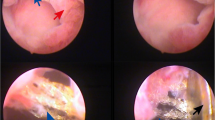Abstract
Transobturator midurethral slings (TOT) have been shown to have less risk of vascular and visceral injury than tension-free midurethral slings. Routine cystoscopy has therefore not been felt to be necessary. A case of bladder perforation unrecognized at the time of TOT placement is presented. Findings at sling removal suggested that a clinically nonapparent paravaginal defect may have been instrumental in the injury. Consideration should be given to routine cystoscopy at the time of transobturator sling placement.

Similar content being viewed by others
References
Delorme E (2001) Transobturator urethral suspension: mini-invasive procedure in the treatment of stress urinary incontinence in women. Prog Urol 11(5):1305–1313
Krauth JS, Rasoamiaramanana H, Barletta H, Barrier PY, Grisard-Anaf M, Lienhart J, Mermet J, Vautherin R, Frobert JL (2004) Sub-urethral tape treatment of female urinary incontinence—morbidity assessment of the trans-obturator route and a new tape (I-STOP): a multi-centre experiment involving 503 cases. Eur Urol 36(1):102–105
Fischer A, Fink T, Zachmann S, Eickenbusch U (2005) Comparison of retropubic and outside-in transobturator sling systems for the cure of female genuine stress urinary incontinence. Eur Urol 48:799–804
Minaglia S, Ozel B, Klutke C, Ballard C, Klutke J (2003) Bladder injury during transobturator sling. Urology 53(2):365–366
Hermieu JF, Messas A, Delmas V, Ravery V, Dumonceau O, Boccon-Gibod L (2002) Bladder injury after TVT transobturator. Prog Urol 13(1):114–116
Ulmsten, U, Henriksson L, Johnson P, Varhos G (1996) An ambulatory surgical procedure under local anesthesia for treatment of female urinary incontinence. Int Urogynecol J Pelvic Floor Dysfunct 7:71–75
Whiteside JL, Walters MD (2003) Anatomy of the obturator region: relations to a trans-obturator sling. Int Urogynecol J Pelvic Floor Dysfunct 14:223–225
Segal JL, Vassallo BJ, Kleeman SD, Silva WA, Karram MM (2003) Paravaginal defects: prevalence and accuracy of preoperative detection. Int Urogynecol J Pelvic Floor Dysfunct 14(5):367–373
Author information
Authors and Affiliations
Corresponding author
Rights and permissions
About this article
Cite this article
Smith, P.P., Appell, R.A. Transobturator tape, bladder perforation, and paravaginal defect: a case report. Int Urogynecol J 18, 99–101 (2007). https://doi.org/10.1007/s00192-005-0050-1
Received:
Accepted:
Published:
Issue Date:
DOI: https://doi.org/10.1007/s00192-005-0050-1




